Social inequality: excessive polarization of society threatens the country's security
Classes in the Union, before the revolution and in post-Soviet Russia
In modern Russian society, a distinct class structure began to take shape after the formation of a class of entrepreneurs - owners began in the Soviet Union in the last years of its existence. Before that, in the USSR, the social structure of the population was strikingly different from the capitalist countries of the world. Most Western countries have much in common in the nature of the social structure of the population. As a rule, in developed Western countries, there are five main layers. First, it is the elite. The super-rich people - big entrepreneurs - industrialists and financiers, stars of show business, politics, generals, hereditary aristocracy belong to this social stratum. The second group is the top middle class, consisting of representatives of top management and status officials, as well as highly qualified professionals. The third group is the middle class, or “professionals”, which includes highly qualified specialists, as a rule, engineering and technical workers, doctors, teachers, lawyers, officers and many others. This class is distinguished by the presence of education, the relatively high incomes of its representatives, but it does not have serious power and financial resources.
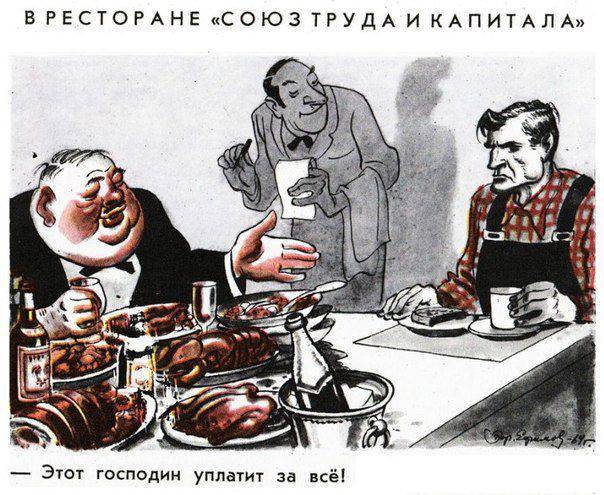
The fourth layer - “basic” - consists of the majority of skilled workers, who, however, do not have higher education and cannot get into a higher social stratum due to being in less status positions. Meanwhile, the incomes of this part of the population are very high and it is impossible to count them as “social lows”. Moreover, they perform qualified work, have official status. Finally, the fifth layer is the so-called prekariat. The main difference between the prekariat as a class in the modern world is the lack of social guarantees. "Prekariya" working in an unstable mode, do not have a clearly defined wage. At the same time, in this category of workers can be both freelancers - specialists, and people without education and any qualifications, interrupted by odd jobs. In any case, the position of the precariate is characterized by extreme social instability, which affects both the financial condition and the political loyalty of the representatives of the “unwarranted” segment of the labor market. In addition to the prekariat, there is still, of course, the real social bottoms - the world of lumpen, people without education, burdened by the burden of numerous social vices, most often found or having been in serious trouble with the law for a long time. The lumpen world is a special social environment, which does not make sense to consider that in the framework of the traditional notions of “poverty” or “prosperity”, since a representative of this social stratum can spend a lot of money to satisfy their needs for alcohol or drugs, but at the same time lead everyday life in real poverty itself. It is this feature of the representatives of the underclass who make them so different from the rest of the poor and, at the same time, somewhat out of the limits of our article itself.
In pre-revolutionary Russia, according to a study by the Petersburg sociologist Boris Mironov (see the journal Sociological Studies, No. 8, 2014), the poorest segment of society was unskilled workers and lumpen. In the lowest income group of the Russian population in 1901-1904. included: 1) beggars, vagrants, wanderers, inhabitants of almshouses; 2) farm laborers (farm laborers); 3) day laborers and laborers; 4) women and children engaged in industrial production. However, social inequality in the Russian Empire was not as widespread as in the United States of America or in Great Britain. At the same time, American citizens, translated into the ruble equivalent, were much richer than the Russian inhabitants. If to the richest Russians in 1900-1910. Were people with an average income in 991 ruble, then the richest Americans - people with an average income in 8622 ruble. At the same time, in Russia, in contrast to Western countries, there was no numerous middle-class stratum already present in the West, and the overwhelming part of the country's population differed greatly in life from the insignificant stratum of aristocracy, rich merchants and manufacturers. This difference is evidenced, at least, by the almost total illiteracy of the broad masses of the Russian population, which already in the post-revolutionary period caused the obvious need for mass eradication of illiteracy among the adult population of the Soviet state.
In modern Russia, due to its historical and political specificity, a slightly different type of social structure has developed. It is distinguished, firstly, by a high level of coalescence of power and large business. It is often difficult to understand “where a businessman ends and an official begins,” and vice versa. Famous sociologist O.I. Shkaratan (Shkaratan OI Socio-economic inequality and its reproduction in modern Russia. M, 2009) believes that modern Russian society is divided into the following main groups. First of all, this is an extremely small class of large and medium-sized owners - somewhere around 4% of the population. Secondly, this is the “middle class” - small entrepreneurs, managers, professionals, working “on themselves”. There are no more than 22%. Finally, the third group consists of performers - non-owners. These include 74% of the population of Russia - here and “state employees”, and ordinary employees of private companies, and the working class. Of course, this model of class classification in modern Russia is very conditional, but it more or less accurately reflects the division of Russian society on such an issue as attitude to property. There are very few full-fledged owners in Russia and in this country is different from Western countries where there are developed traditions of entrepreneurship. It is known that the number of small and medium-sized enterprises and, accordingly, people engaged in the field of small and medium-sized businesses, in modern Russia is much less than in most developed countries of the world. Meanwhile, this is a very alarming trend, since small and medium-sized businessmen, which are the basis of the "middle class", are a very stable and socially stable contingent, usually patriotic, active, that is, they are of great value to the country. It would seem that the Russian state should support small and medium-sized entrepreneurs, but in practice it turns out that small and medium-sized businesses most often experience serious problems in the country.
The specificity of the Russian situation is that in Russia, as in many countries belonging to the “third world,” the possession of power resources often turns out to be more significant than the possession of property, even if it is large. For example, the position of an employee of the security forces or the administration of a city, district, rural settlement may be more important than the position of an entrepreneur, even though formally the security official or official belongs to the class of performers, and the businessman - to the class of owners. Secondly, in Russia, due to the colossal geographic differences of its regions, there is also an obvious separation between the residents of the capital and the inhabitants of the province, the inhabitants of large cities and small cities, and especially the countryside. So, even a low-income resident of the capital who is not working or working for non-status and poorly paid work, but who has housing in Moscow, selling housing and moving to the provinces, can turn into a secured "rentier" living on the interest from the contribution to the bank of funds received for selling the property. Selling even an inexpensive housing by Moscow standards will give him the opportunity to have a very high income for the province. That is, there is both a “power” plane of social inequality and a “geographic” plane of social inequality. In the first plane, the following groups can be distinguished: 1) representatives of high officials; 2) representatives of the middle layer of administrative workers, senior officers of power structures; 3) private entrepreneurs 4) base layer of performers who do not have a powerful resource; 5) social bottoms. In the second plane, the following categories are unequivocally distinguished: 1) residents of the capital, Moscow; 2) residents of St. Petersburg and suburbs of Moscow; 3) residents of major urban centers (Yekaterinburg, Novosibirsk, Rostov-on-Don, Krasnoyarsk, etc.); 4) residents of regional centers; 5) residents of small towns and regional centers; 6) rural residents. Of course, within each of these categories there is also a differentiation - for example, the situation of residents of coastal cities, who have the opportunity to extract income from the resort business and trade, and residents of depressed cities and settlements - former mining and factory towns and villages.
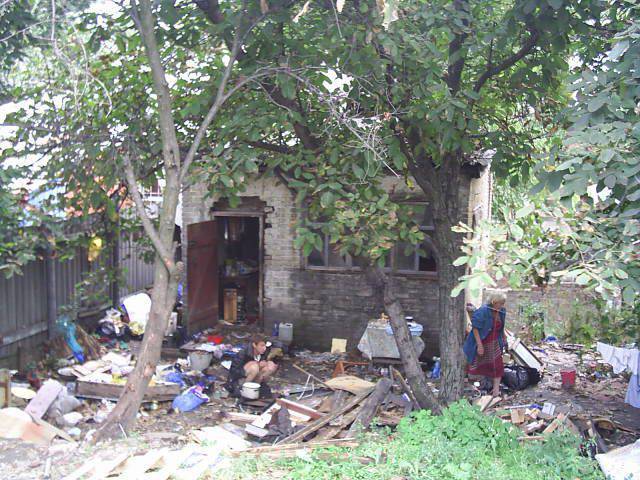
On the causes of poverty
Of course, for everyone who is concerned with the problems of social inequality in modern Russia, the question inevitably arises as to what are the main causes of poverty. Why some people can maintain a more or less decent standard of living, while other people are literally on the verge of survival. According to sociological research data, the representatives of the Russian lower strata of society call the long absence of work, the small size of state social benefits and family unhappiness and incidents as the main causes of their own poverty. Indeed, unemployment is a very serious problem for Russia, especially in small cities and rural areas, and the long-term lack of work and permanent income inevitably throws a person into a marginal environment and contributes to the marginalization of his lifestyle. On the other hand, insignificant, if not insignificant, basic social benefits remain - pensions for the majority of employees; allowances for single mothers and large families; survivor’s benefits; unemployment benefits; disabled pensions. Many pensioners in Russia still receive 6 thousand rubles per month, and this is despite the fact that the rent for modest housing can reach half of the said amount of pension. At the same time, many Russians polled by sociologists are convinced that poverty in modern Russia is often caused by social vices — drunkenness, drug addiction, parasitism, and also personal characteristics — lack of initiative, laziness, and the absence of a “life pivot”. It turns out that many of the poor, from this point of view, are themselves to blame for their financial distress. It is possible that when people talk about drunk or cracked people, there is a certain amount of truth here. But are pensioners - doctors, teachers, teachers who have worked for forty years for the benefit of the Soviet and Russian state - are they to blame for their miserable situation? It is hardly possible to call young and not-so-young professionals guilty in their position, who continue to work in polyclinics and schools, universities and libraries, museums and theaters, factories and in the agricultural sector for very little money.
However, it should be noted that in recent years, or more precisely even a decade, the level of well-being of Russians as a whole has slightly increased. Gradually, “poverty” becomes inherent in rather marginalized groups of the population, which is reflected in the general attitude of Russians towards poor and “poor” fellow citizens. Traditionally, Russian society was characterized by a sympathetic attitude towards poverty and the poor, as evidenced by numerous popular sayings. The humane attitude towards poverty is characteristic of most literary works, moreover, in some cases, poverty is even considered as a “social quality” worthy of respect. Contempt for poverty, the assertion that poor people themselves are to blame for their fate, is more characteristic of Western culture based on Protestantism. The social doctrine of Protestantism, especially Calvinism, suggests that rich people are more devout Christians than poor, because they tend to accumulate as a result of their asceticism, self-discipline and self-restraint. Poor people pay for their vices and sins with their poverty. For Russian culture, which was formed on the basis of Orthodoxy, as well as for the cultures of other peoples of Russia, professing other traditional confessions for our country, this attitude to the rich and poor was not considered normal. The poor and the "poor" were helped, and this help was considered a blessing both in Christianity and in Islam.
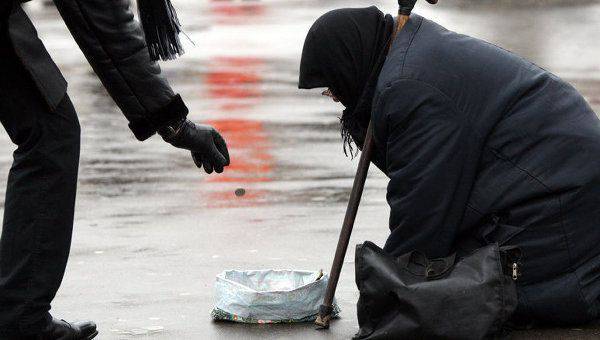
In modern Russia, there is a rather clear and justified concept of social reality of poverty. According to him, the poor residents of the Russian Federation are those people who have incomes around 9000 rubles per capita. Most of the country's citizens earn approximately 40-50% more from this amount. At the same time, the official threshold of poverty, about which the government of the country speaks, is “the subsistence minimum”, is significantly lower than the ideas of the majority of Russian citizens about what to consider the poverty line. In fact, if one can hardly live on 9 thousand rubles, then on 5-6 thousand rubles it is almost impossible to live, at least when this money is the income of one person. Of course, in a family, the situation varies somewhat and a family of three is difficult, but it can survive for a month in the amount of about 15-20 thousand rubles. What is considered a sign of poverty in modern Russia? Firstly, this is a poor quality of food, the impossibility of acquiring new and high-quality clothing, and poor housing conditions. Most of the poor live in communal rooms, in dormitories, emergency and dilapidated housing. The poor part of the population is characterized by inequality of chances to get a quality education and to find employment in prestigious areas of activity, it has incomparably lower cultural and social capital. Nevertheless, as a result of the economic reforms of 1990, in the Russian Federation, there was a massive impoverishment of the population, including intellectuals, skilled workers. People in their professional skills and skills, in terms of education level, would have been in the West as a professional or base stratum, in Russia were below the poverty line as a result of the collapse of industry and agriculture, massive and long-term non-payment of wages, and sharp inflation. It is because of the political and economic upheavals that have befallen the Russian society in the 1990-s, that Russian poverty acquired such diverse outlines. The poor can be both a school teacher, a retired military plant engineer, and a drunkard who has not worked anywhere his whole life and has drunk his house.
Stratification of the poor
Like society as a whole, the class of the Russian poor is also differentiated. Sociologists distinguish several major groups that are classified as poor. First of all, it is "poor in deprivation." These include 25% of Russian citizens who, due to lack of income, cannot fully meet their needs for quality housing, education and medical care, leisure, food and clothing. Another, less numerous group is about 9% of the Russian population. These include citizens with a very small per capita income not exceeding the subsistence minimum per person established in a particular region. Another 4% of Russian citizens are classified as "chronically poor." As a rule, the chronically poor are in such a social position for at least five years and have long accepted and accustomed to their existence on the periphery of the social hierarchy of Russian society. Most of the chronically poor cannot fully meet their most basic needs - they are forced not to eat up, they dress very badly, there is no talk about rest, high-quality medical care, education. The living conditions of this category of the Russian population are also extremely unsatisfactory. At the same time, the world of social lower classes is not in all cases identical with the income poor. For example, some representatives of the lumpenized strata of the population, especially balancing on the verge of the legitimacy of their earnings, may have quite good average incomes, but their propensity for antisocial behavior and marginal lifestyle does not allow them to constructively manage the funds they receive - as a rule, cash in In this case, they are not spent on medical services, education, or the purchase of furniture, but on alcohol and drugs. It should be noted that many people who are, in fact, not poor, actually live like the poor precisely because they do not know how to manage their own salaries, suffer from alcohol and drug addiction or gambling, are infantile in financial matters - that is, they themselves reduce your standard of living. In fact, in this case, those who accuse the poor of their “troubles” are right, proceeding from the inclination of a significant part of the latter to social evils. However, this concerns, again, first of all, the marginal segment of the Russian poor. And even then, a mass culture based on the ideology of consumerism and directing people to maximize the consumption of often unnecessary goods and services, to maintain the illusion of supposed wealth, which forces them to take loans, only aggravating and already unstable financial situation.
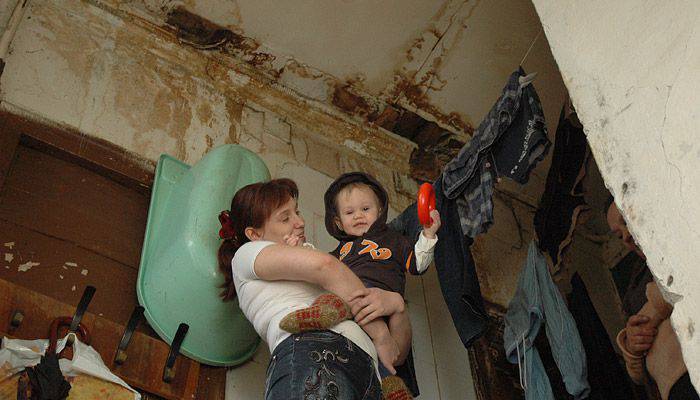
Despite the fact that all over the world, the most deprived categories of the population have traditionally been the unemployed and not working people, in modern Russia, the majority of the poor are working citizens. At the same time, the level of wages of the working poor may not exceed the level of the subsistence minimum per capita. So, in Russia, there are still wages in the amount of 5-6 thousand rubles, and they are paid to employees employed throughout the working day, including those who have certain qualifications. The least paid categories of the working population are nannies and junior kindergarten teachers, librarians, museum workers, nurses. Their incomes are much lower than those of unskilled laborers, cleaners, and other persons engaged in heavy and unskilled manual labor. A significant part of these “working poor” simply can not physically survive without additional income or help from other family members - husbands or wives, older relatives or adult children. At the same time, the availability of education and qualifications of many of them does not allow attributing to the social lows of the country's population, while in terms of income they are on the verge of falling into the social stratum of the poor. Finally, the working poor can be attributed to specialists who were suddenly unemployed and who exist for unemployment benefits, which also has a very modest size in Russia. Finally, the working poor are people who can have good incomes, but whose composition of disabled family members causes them to divide their incomes among all family members. Thus, in most cases, having many children is one of the most important reasons for Russian citizens to fall into the category of poor.
A major role in the formation of social inequality in modern Russia is played, as already noted above, by the regional factor. The bulk of the Russian poor live in rural areas and small “depressed” cities. It is in the village and monotowns in the 1990-ies. the most terrible blow was dealt - enterprises and collective farms were closed, new jobs did not appear, as a result of which an impressive part of the population became unemployed and was relatively marginalized. Many villagers live only on the pension of senior relatives and disabled relatives, as well as on occasional earnings, which are of a single character. In a large city, it is much easier to find a job with a salary that allows at least a more or less tolerable existence. This factor contributes to the gradual depletion of rural areas, as internal migration from villages and small towns to large cities develops, primarily to the country's capital, St. Petersburg, the largest shopping and industrial centers, to cities of regional and regional importance. Belonging to the social category of the poor, on the other hand, affects the ability to get more or less interesting, prestigious, or decently paid work. A poor person is deprived of the starting resource with which a representative of another social category can begin his work activity. For example, a poor person who does not own a car loses most of the chances of being employed as a taxi driver. Even more vacancies become unavailable to him in the absence of education, professional qualifications, but the poor person does not have the opportunity to receive education, if only because he does not have the resources to ensure his existence during his studies. Finally, the social capital of the poor is very limited, since they are increasingly “cooking in their own environment,” which implies the absence of connections among prosperous categories of the population.
Hereditary poverty threatens social order
The transmission of "poverty" by inheritance is becoming increasingly commonplace in modern Russia. So, at least half of the total number of the modern Russian poor were born and brought up in poverty. Accordingly, they, more often than not, do not possess the proper social capital, nor cultural capital, nor personal qualities and ideological reference points that could allow them to escape from poverty. This category of the population becomes the bearer of the “culture of poverty,” which develops on the periphery of Russian society. On the other hand, the possession of cultural and social capital with a very high degree of probability guarantees a way out of poverty in the event of a sudden situational falling into the stratum of the poor (the latter can happen to non-poor people in the event of ruin of their own business, dismissal from work, problems with the law, etc.) P.). Most of the non-poor before people who accidentally fell into a state of poverty sooner or later again leave the stratum of the poor and move into more prosperous sections of society, which is most often a consequence of the “inclusion” of a number of resources - from their own intellectual and professional potential to using social connections.
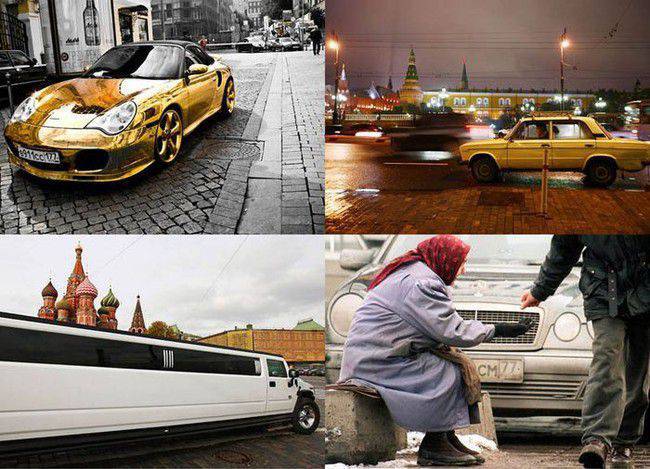
At the same time, it would be wrong to assess the real standard of living of the population in Russia, guided only by official statistics and sociological research materials. It should be noted that the standard of living varies not only among different social strata, but also among different age groups of the population. Impact on the standard of living have not only income, but also expenses. Moreover, lending is widespread in Russian society, as a result of which people who are really poor can make an impression of more or less prosperous people (mortgage apartment, car loan, furniture collected on credit, and household appliances, while paying loans) leave almost all wages, that is - there is no money left to meet the simplest necessities of life). On the other hand, people can receive very little income, but at the same time have solid property. For example, many Soviet-era pensioners own apartments, garages, summer cottages, the total cost of which may be many millions of rubles. However, the monthly pension received in 6-10 thousand automatically makes it possible to assign the pensioner to the poor part of the population, although his funds in the form of real estate can be very significant. Finally, you should consider the huge segment of the shadow labor market. Officially, people employed in the shadow sector of the economy are considered to be unemployed or unemployed, have little or no income, but the real level of their earnings can be quite decent and even very significant. Finally, there is another category of poor - these are foreign labor (and non-labor) migrants who find themselves on the territory of Russia and work in low-paying jobs, or who have lost it due to the economic crisis and have failed to return to their home countries. The emergence of a large number of foreign marginals is a particular threat to the security of the country and public order, and in recent years not only criminals have appeared among migrants - due to the cultural specifics, many of them are recruited by radical organizations operating both in Russia and abroad. Considering that the control over migrants is not effectively implemented, this trend looks very dangerous, especially in the light of the current military-political situation in the Middle East or in Ukraine.
The presence of a large number of poor people in modern Russia is aggravated by the colossal difference in the standard of living that exists between the main part of the country's population and the "super-rich." Approximately about a hundred of the richest families currently control no less than 35% of Russia's national wealth. The social polarization of the population in Russia reaches colossal proportions, comparable only with some developing countries. Meanwhile, the presence of such large-scale social inequalities is a direct threat to social stability and political order in the Russian Federation. Since there is a “preservation” of poverty, which is acquiring more and more hereditary class traits, sooner or later the phenomenon of “class hatred” will arise, which is still absent from the modern poor, who blame themselves, their fate, the current government, but the social system that led to this level of social stratification. For the Russian poor, on the whole, political inactivity is rather characteristic. They are not interested in politics, primarily because they do not believe in the possibility of any real change in their social status, and if their own social position does not change, then there is no point in requiring any political changes in the country. Secondly, the majority of poor Russians are characterized by an increased focus on commonplace survival, which also leaves them no time and energy for any political or social protest activity.
But at the same time it is impossible to deny the fact that with the effective influence “from outside” the huge masses of the Russian poor can turn into a very explosive contingent. Any anti-state forces interested in undermining the political and social order in the country can use the social discontent of the Russian poor. Moreover, these forces can raise the slogans of social justice, in reality, absolutely not going to put them into practice. That is, the social inequality inherent in modern Russia can play a very negative role in the fate of the country - at least if the state does not take up the solution of the accumulated numerous social problems of Russian society. It is difficult to disagree with the Russian political scientist Alexander Karatkevich, who believes that “exceeding the permissible degree of inequality leads to a large difference in the standard of living of certain status groups in society, which can be regarded as discrimination and disadvantage of some groups of the population. This circumstance often leads to the emergence of social tension in society, serves as a fertile ground for the emergence, development and spread of social conflicts. Therefore, every society should develop a system of regulators to reduce the degree of social inequality ”(Karatkevich, AG Social inequality as a threat to political stability and public safety // PolitBook, No. 4, 2014).
Is it possible to change the existing social stratification due to public policies aimed at reducing social inequality? Of course. This is evidenced by the experience of a number of European countries, in which, at the beginning of the twentieth century, the level of social inequality far exceeded the Russian indicators, but by the end of the twentieth century the distance between the richest and the poorest citizens was many times reduced. But solving the problem of social inequality will require appropriate efforts from the leadership of the Russian state. Whether the current political elite will be able to sacrifice their individual financial interests and put the interests of Russia, its stability and development, higher than their own, or not - the reduction of the social polarization of Russian society depends in the first place.
Photo materials were used: http://nnm.me/blogs, pro100news.info.
Information